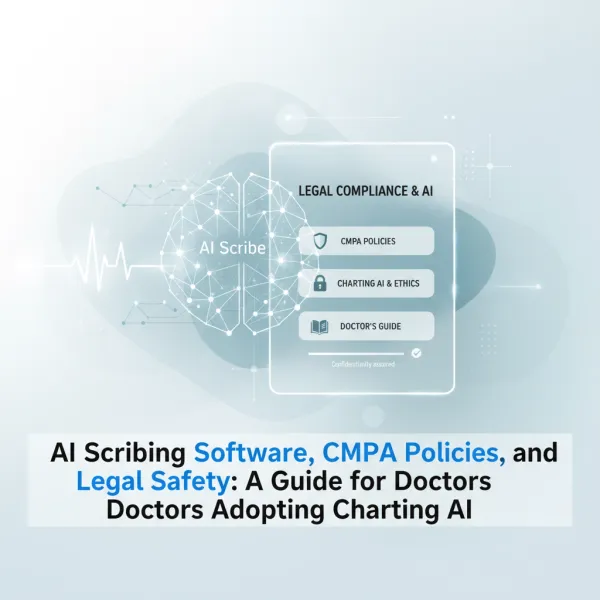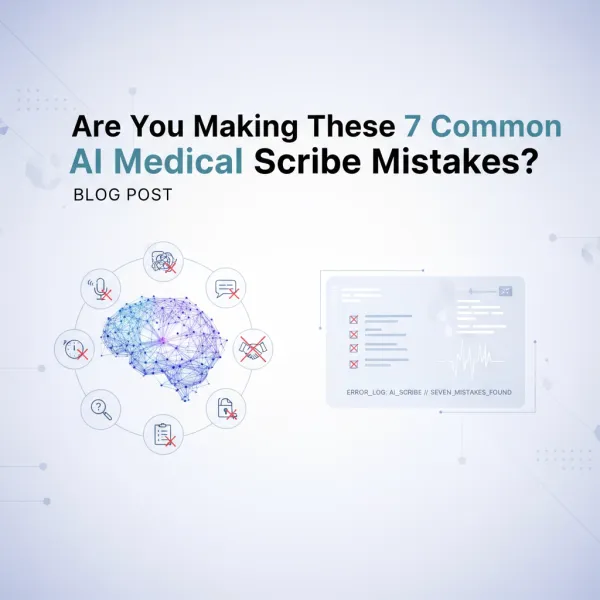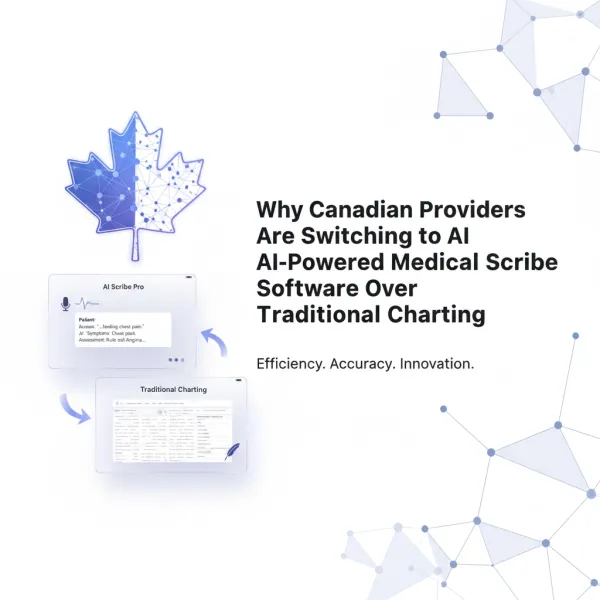CMPA Guidelines on patient consent for AI Medical Scribes
Understand the CMPA guidelines on patient consent for AI medical scribes, ensuring compliance and maintaining patient trust.

AI medical scribes help doctors by converting conversations with patients into electronic health records (EHRs). However, patient consent is mandatory before using such tools. The CMPA (Canadian Medical Protective Association) outlines clear steps to ensure compliance with privacy laws, ethical standards, and patient trust.
Key Takeaways:
-
Consent Requirements:
- Explain how data is collected, stored, and used.
- Allow patients to opt out without affecting care.
- Document consent in the EHR.
-
Consent Types:
- Real-time transcription (no audio storage).
- Audio recording storage (with retention details).
- AI learning data (separate consent for algorithm improvement).
- Legal Compliance:
-
Best Practices:
- Use written, verbal, or hybrid consent methods.
- Maintain clear EMR documentation with audit trails.
- Provide multilingual patient materials and FAQs.
Integrating AI Scribes - What to Include in Your Patient Consent Forms
Legal Requirements for Patient Consent
The CMPA outlines three key legal responsibilities for Canadian healthcare providers when obtaining patient consent:
Clear Communication Standards
Healthcare providers must use simple, straightforward language when explaining AI scribes to patients. According to the CMPA, this includes discussing:
- The purpose and how the AI scribe works
- Methods of data collection, storage, and protection
- Possible uses of the recorded information
- The patient’s right to opt-out at any time
This approach ensures transparency, builds trust, and safeguards both patients and providers under legal standards.
Privacy Laws Across Regions
Compliance with privacy laws varies depending on location and practice setting. Canadian healthcare providers must follow these privacy frameworks:
| Privacy Framework | Jurisdiction |
|---|---|
| PHIPA | Ontario |
| PIPEDA | Federal |
| Provincial Laws | Various |
For practices that operate across provincial or national borders, CMPA advises:
- Disclosing international data handling practices
- Adhering to all relevant privacy standards
- Strengthening security measures to protect patient information
These requirements play a crucial role in shaping how consent processes are managed.
Data Collection Consent Types
CMPA's guidelines highlight three levels of consent based on how the AI system functions:
- Real-time Transcription: Covers immediate documentation without storing audio files.
- Audio Recording Storage: Includes details about retention periods, security protocols, access restrictions, and data deletion processes.
- AI Learning Data: Requires separate consent for using de-identified data to improve AI algorithms.
Centralized systems should be used to track consent, handle opt-outs, and maintain audit records effectively.
Setting Up a Consent Process
To comply with CMPA's legal guidelines, follow these steps:
Choosing Consent Methods
Pick a consent method that fits your practice's needs:
| Consent Method | Best For | Documentation Needed |
|---|---|---|
| Written Consent | New patients, Complex AI use | Signed form in EMR, Renew annually |
| Verbal Consent | Follow-ups, Simple AI tasks | EMR note with date and key details |
| Hybrid Approach | Most clinical environments | Written consent initially, then verbal updates |
This approach ensures proper documentation, aligning with CMPA's focus on managing risk effectively.
Required Patient Disclosures
Patients should be informed about these key points to meet CMPA's transparency standards:
- The role of the AI scribe in their documentation.
- How their data is managed and protected.
- Options available for opting out.
EMR Consent Documentation
Maintaining clear and consistent records in the EMR meets CMPA's audit requirements [3].
Key elements for CMPA-compliant documentation:
-
Standardized Templates
Use pre-designed consent forms to capture patient information, permissions, and dates. -
Status Tracking
Implement color-coded flags in the EMR for quick reference:- Green: Active consent
- Yellow: Renewal due
- Red: Opted out
-
Audit Trail
Ensure the following details are recorded:- Dates of initial consent and renewals
- Any changes in consent status
- Notes on discussions with patients about their choices
Patient Communication Guide
Effective patient communication is key to ensuring CMPA guidelines are applied in real-world settings, especially when introducing tools like AI medical scribes.
Sample Patient Conversations
Here’s a CMPA-aligned way to talk to patients about AI medical scribes:
- Introduction: "I use an AI medical scribe to help create your medical record. This allows me to focus more on you during our visit. Is that okay with you?"
- Consent Request: "Would you like to proceed? You can change your mind about this at any time."
Patient Information Materials
Providing clear, accessible information helps patients understand and feel comfortable with AI scribes. Consider these resources:
-
Digital Handouts
Use simple language and visuals like process diagrams to explain how AI scribes work. Highlight benefits such as more accurate records and increased face-to-face interaction during appointments. -
FAQ Documents
Address common concerns, such as:- How human oversight ensures accuracy
- Assurance that opting out won’t affect the quality of care
-
Multilingual Resources
Offer translated materials in the most commonly spoken languages among your patients.
Managing Patient Opt-Outs
If a patient chooses to opt out, ensure their decision is respected while maintaining care quality. Use EMR tracking methods for manual documentation and reassure them:
"I completely understand your choice. We’ll document your visit manually as we always have. Your care will not be affected."
Collecting and acting on patient feedback can help improve the consent process over time.
AI Scribe Vendor Selection
When choosing an AI medical scribe vendor, healthcare providers need to ensure the solution aligns with CMPA's privacy requirements. Here's what to focus on:
Vendor Security Standards
Security is non-negotiable. Look for these critical features and certifications when evaluating vendors:
Core Security Features
- End-to-end encryption
- Strict access controls
- Systems audited by third parties
- Disaster recovery plans
| Compliance Requirement | Verification Method | Priority Level |
|---|---|---|
| Privacy Impact Assessment | Request detailed documentation | Mandatory |
| Consent Management Tools | Demo of built-in consent features | Required |
| Audit Trail Capabilities | Review logging and monitoring systems | Essential |
Scribeberry Features Review

Scribeberry stands out in the AI medical scribe market, offering tools tailored to CMPA's consent documentation standards.
Security Implementation
- Infrastructure designed to meet CMPA guidelines, including encrypted data handling
- Comprehensive audit logging system
- Role-based access controls for added security
Clinical Workflow Integration
- Compatible with any EMR system
- CMPA-aligned consent templates
- Built-in consent forms for seamless operation
Key Considerations for Implementation
To ensure smooth adoption, healthcare providers should confirm the vendor offers:
- Detailed Privacy Impact Assessments
- Clear policies on data retention and storage
- Transparent documentation on AI data processing
- Direct integration with existing consent documentation workflows
Maintaining Compliance
Ensuring ongoing compliance after adopting AI scribes involves focusing on three key areas:
Staff Training Requirements
A solid training program is essential to keep staff informed and skilled. Here's a breakdown:
| Component | Frequency | Focus Areas |
|---|---|---|
| Core Skills | Quarterly | Consent updates, security |
| System Changes | As released | New features, workflows |
| Compliance | Monthly | Guideline updates, audits |
Patient Feedback Systems
A feedback system that meets CMPA guidelines should use various methods to gather and analyze input:
- Real-time feedback through post-visit surveys
- Monthly patient discussions to address concerns
- Ongoing analysis of recurring feedback trends [2][5]
Update Management Protocol
To stay compliant with CMPA standards, follow a structured approach to system updates:
| Stage | Key Actions |
|---|---|
| Preparation | Security reviews, thorough testing |
| Deployment | Gradual rollout with training |
| Evaluation | Monitor system performance for 30 days |
Incorporate these practices into daily workflows and assign clear responsibilities based on CMPA's compliance oversight recommendations. This ensures smooth implementation and adherence to guidelines [1].
Conclusion
For healthcare providers using AI medical scribes, staying compliant and maintaining patient trust is essential. This involves clear communication, robust privacy measures, and consistent adherence to guidelines.
To ensure CMPA compliance with AI scribes, focus on these key actions:
- Confirm that consent documentation meets current standards.
- Provide quarterly training updates for staff.
- Annually review vendor security certifications.
- Simplify opt-out tracking within EMR systems.
By regularly auditing these areas and applying effective patient communication strategies, providers can use AI scribes responsibly while respecting patient rights.
Key Points for Continued Success
- Patient Autonomy: Offer a straightforward opt-out option for patients who prefer traditional documentation methods [2].
Following the Update Management Protocol, routine system audits are critical for maintaining compliance and optimizing AI scribe use. Providers should also stay updated on CMPA guidelines and advancements in consent documentation tools.
Clear communication about how patient data is used and protected is a cornerstone of successful AI scribe implementation. Regularly reviewing consent processes and adhering to Audit Trail requirements ensures high standards while integrating AI into clinical workflows.
FAQs
Should I agree to the use of an AI Scribe?
When deciding, patients should consider:
- How their data is protected
- Potential advantages, such as more direct interaction with their healthcare provider
- Whether anonymized data might be used to improve AI systems
This approach aligns with CMPA's focus on respecting patient choice. For more on how healthcare providers handle consent, check out the EMR Consent Documentation section.
Is patient consent required for using AI?
Yes, as stated in the Legal Requirements section, CMPA requires obtaining consent before recording clinical interactions. These rules are based on established privacy protocols [1][4].
Healthcare providers must:
- Clearly explain how AI is being used
- Provide details about data security
- Document the patient's consent
If you work in a hospital or healthcare setting where you don't manage the records, ensure you get permission from the institution before using AI scribes [3].



